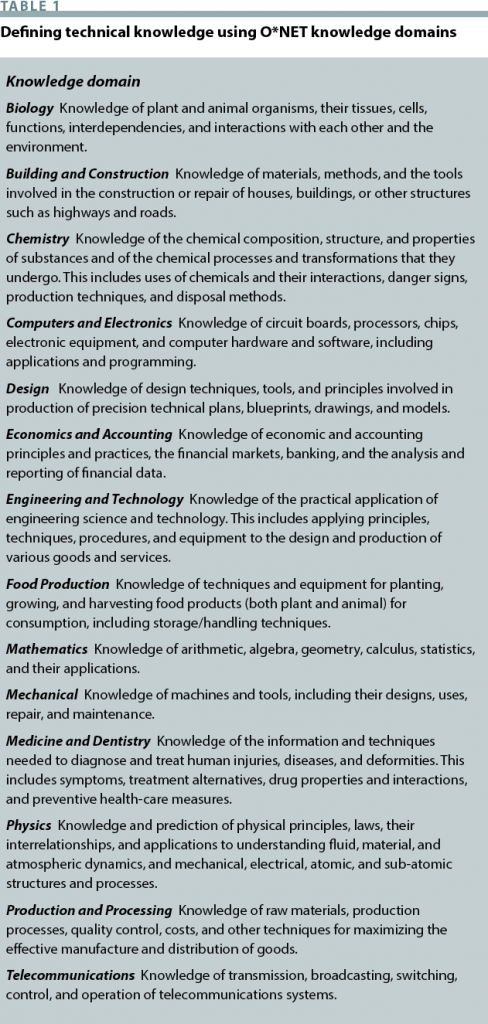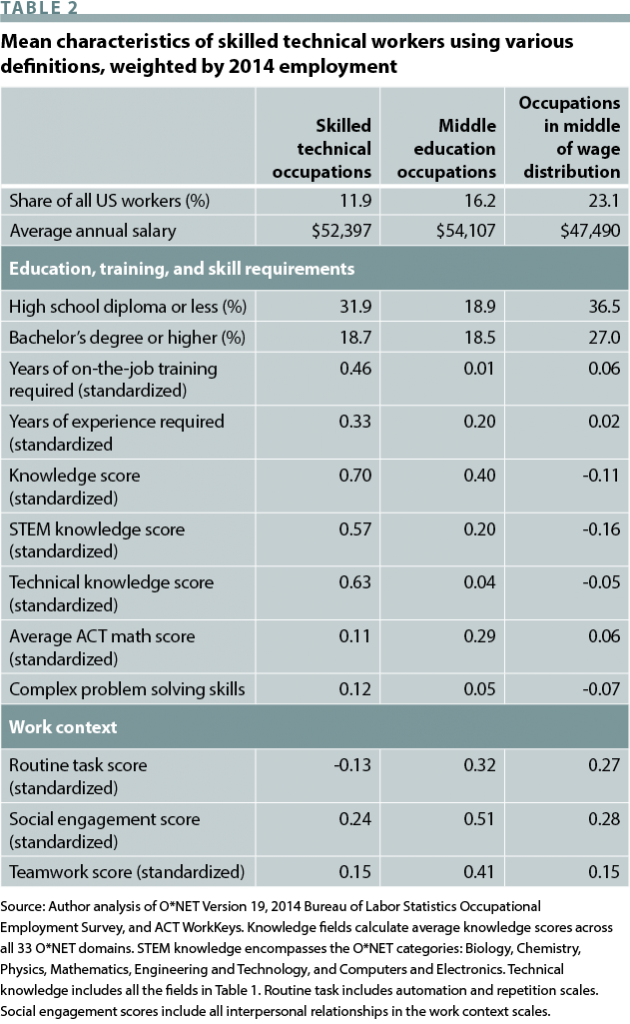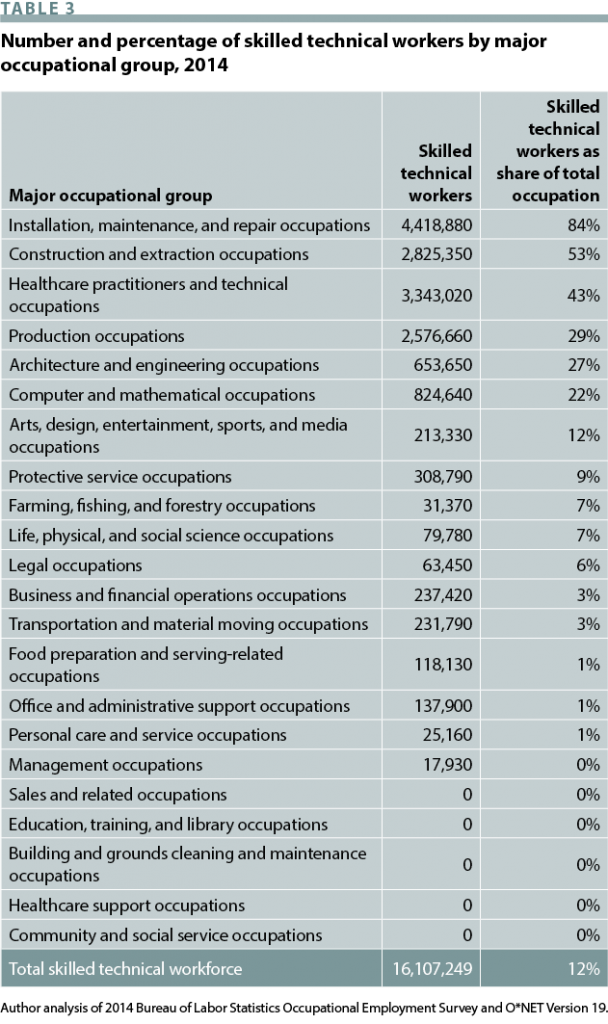Defining Skilled Technical Work
The nation needs to better understand and more effectively develop this essential component of the US workforce.
Humans were generally poor until the industrial revolution unleashed a flurry of innovative activity. Many might assume that the intellectual and entrepreneurial breakthroughs were driven by highly educated elites who graduated from leading universities. In fact, it is well documented that high-skilled blue-collar and technical workers, in machinist and production occupations and typically with no post-secondary training, made the largest direct contributions to innovation during the industrial revolution, as measured by patenting activity and other indicators. The predominance of blue-collar workers in technological innovation continued well into the second half of the twentieth century.
As employment in manufacturing has gradually eroded, skilled technical workers—varyingly called trade workers, craft workers, or somewhat more pejoratively, middle-skilled workers—have received little attention among social scientists, but many of these occupations remain a viable pathway to the middle class for millions of Americans and play a critical role in maintaining the nation’s economic productivity. Thus, a more precise understanding of these occupations and their training requirements could lead to fruitful policy reforms that enhance individual well-being and national economic vitality.
The study of skilled technical workers goes back to the origins of economics as a disciple. In The Wealth of Nations, Adam Smith offered a succinct definition of skilled laborers: “The policy of Europe considers the labor of all mechanics, artificers, and manufacturers, as skilled labor.” He distinguished this group from skilled professionals, such as academics and lawyers.
Contemporary scholars have defined this group of skilled technical workers variously by their occupational categories, their wages, or educational characteristics. Some define middle-wage occupations as having earnings between 75% and 150% of the US median wage. Within middle-skilled jobs, economists have also distinguished between occupations that perform routine versus nonroutine tasks or those in newer and growing versus older and declining occupations. A report from the National Research Council defines middle-skilled jobs as requiring education or training beyond high school, but less than a four-year degree.
There are strengths and weaknesses in all these definitions. Using wages to gauge middle-skilled occupations can be misleading because workers in the middle of the wage distribution may be relatively unskilled but compensated well because of union contracts or other characteristics of the industries in which they commonly work. Likewise, some low-wage occupations may be relatively skilled but experiencing negative wage trends as a result of trade, immigration, or technological change. Using educational requirements also runs into difficulty because there is tremendous variation in the technical skills of people who have the same level of education.
For these reasons, it is important to include measures of skill in the definition of skilled technical workers, for it is their mastery of certain knowledge domains and techniques, not their level of education or salary, that distinguishes them. I propose that a skilled technical occupation should meet two criteria: a high level of knowledge in a technical domain and openness to workers without a bachelor’s degree.
The first criterion distinguishes low-skilled jobs from skilled jobs. It also distinguishes occupations that require nontechnical knowledge such as writing, law, foreign language, management, and sales from those requiring technical knowledge. For the purposes of this definition, technical knowledge refers to the domains listed in Table 1. They extend a little beyond what is usually considered science, technology, engineering, and math (STEM) knowledge.
Within these fields, the next step is to define what a “high” level of knowledge means. I propose using the Department of Labor’s Occupational Information Network (O*NET) classification that rates the skill requirement for all jobs on a scale of 1 to 7. A score of 4 is the midpoint, and I use a cutoff of 4.5, which reflects a significant component of cognitive math skill. The second criterion is needed to distinguish skilled technical work from skilled professional work, which usually requires at least a four-year degree.
Findings
Using the previously mentioned definition, 16.1 million US workers (11.9% of the total workforce) were employed in skilled technical occupations as of 2014. This is a smaller number than what would result from using other criteria. If one used education beyond high school but less than a four-year degree, the percentage would be 16.2%, and if one used the wage distribution of 75% to 150% of the median wage, the total would be 23.1%.
It is widely believed that tacit or informal knowledge—as opposed to that gained through formal education—is important for skilled technical workers. As defined here, skilled technical workers do, indeed, work in occupations that require more experience and training than the average occupation. Likewise, on-the-job-training requirements are significantly higher for skilled technical workers relative to the other two middle-skill definitions.
Notably, the tasks and skill levels of the definitions are quite different. Broadly speaking, the skilled technical occupations report higher general knowledge requirements, greater knowledge in STEM disciplines, specifically, and greater knowledge in the fields most relevant for technical work. On cognitive skill, however, as measured by the ACT WorkKeys exam, each set of occupations performs slightly above average and the differences are not statistically significant among the definitions.
Of the occupations that comprise the skilled technical workforce, very few entail many routine tasks. This may indicate that they are relatively unlikely to be offshored or supplanted by computers in the short term. Previous research identifies clerical occupations, heavily concentrated in administrative positions, as most likely to be exposed to pressure from automation, but just 1% of office and administrative support occupations qualify as skilled technical workers.
Where do they work?
Skilled technical workers are found in a diverse array of occupations. Indeed, of the 22 major occupational categories identified in O*NET, only five have zero occupations that meet the criteria. Most skilled technical workers are in “blue collar” occupations: installation, maintenance, and repair; construction; production; protective services; and transportation and material moving. Yet, many are in traditionally professional occupational families. The second largest group—representing 3.3 million jobs—is health care practitioner and technical occupations, and the fifth largest group—representing 0.82 million workers—is computer and mathematical occupations. Architectural and engineering occupations comprise another 0.65 million.
The occupational family with the highest percentage of skilled technical workers is installation, maintenance, and repair, which also has the highest absolute number of such workers. This category includes general maintenance and repair workers, automotive technicians and mechanics, supervisors of mechanics, machinery mechanics, and HVAC installers. Construction and extraction is next, with just over half of all workers qualifying to be part of the skilled technical workforce. Surprisingly, perhaps, just under one-third of production occupations meet the criteria. Most of these jobs simply do not report sufficient skill levels to qualify, but those that do include carpenters, electricians, plumbers, building inspectors, and telecommunications installers. Computer and mathematical occupations are almost as likely as production occupations to qualify, with 22%. Three titles—computer user support specialists, computer network architects, and web developers—qualify in this family. Registered nurses (within health care practitioners) represent the largest specific skilled technical occupational category. Machinists and production supervisors also qualify under production occupations, as do firefighters under protective service occupations.
Consistent with their distribution across occupations, a high percentage of skilled technical workers report mechanical expertise (52%). A smaller but still large percentage qualify as skilled through medical expertise (21%), knowledge of building and construction (19%), or understanding of computers and electronics (13%). High knowledge scores in other fields, such as economics or physics, are fairly infrequent for skilled technical workers, perhaps because it is difficult to obtain such knowledge without a bachelor’s degree.
Skilled technical occupations disproportionately employ workers with sub-bachelor’s level higher educational credentials. Almost one-quarter of skilled technical occupations report a postsecondary certificate as their highest level of education, compared with only 6% of all other workers. This makes a certificate the most common level of education besides a high school diploma for skilled technical workers. Another 15% of skilled technical workers have earned an associate’s degree, compared with 6% of all other workers. Relative to the rest of the US workforce, skilled technical workers are much more likely to have a postsecondary education beyond a high school diploma, but less likely to have earned a bachelor’s or higher degree.
Although bachelor’s level education is lower for skilled technical workers, on-the-job training is significantly higher. Skilled technical workers report receiving eight months longer on-the-job-training compared with the average worker in other occupations (weighted by employment). Moreover, skilled technical workers tend to have an extra year of experience. Both differences are statistically significant. Taken together, they provide further evidence that skill levels are relatively high for skilled technical workers, even if acquired through less formalized channels, such as on-the-job training and learning.
Policy implications
A broad policy goal of the United States should be to maximize the opportunities of youth and displaced older workers to acquire valuable skills. This requires optimizing policy interventions at multiple stages of life.
Throughout childhood and early adolescence, preparation for a job as a skilled technician should look the same as preparation for a skilled professional job at the highest level of sophistication. In other words, high-quality education in math and reading need to be universally available at the earliest years. A number of rigorous studies show large benefits to high-quality prekindergarten education, but it is rarely provided by the government and is thus unaffordable to the children who would benefit the most from it.
US children and adults consistently underperform their peers in other developed countries on tests of mathematics and science ability. Fortunately, a large and growing literature finds that various school reform policies—such as access to high-quality charter schools, vouchers for low-income children, and sophisticated teacher accountability and pay policies—raise the quality of public education, leading to improved test scores, education levels, and future earnings.
School districts and states can also adopt curriculum-based policies that increase learning opportunities in technical fields. For example, the Virginia Beach school district partners with a local community college to allow any high school student in the district to take rigorous STEM or technical courses that lead directly to industry-designed certificates. Approved apprenticeships at companies that provide on-the-job training should also count toward high school credit.
Likewise, as Harry Holzer has argued, states should use their funding power to provide clear incentives and encouragement to better align funding with high-quality college education. One important and readily measurable aspect of quality relates to the earnings of attendees. My research finds that even fairly crude measures of alumni economic outcomes can be used to construct value-added metrics, which perform better than popular college rankings and can inform the public about the strengths of community colleges and nonselective four-year schools. States should use tax and high school administrative records to construct comprehensive measures of earnings, test scores, and family income to measure and report the value added by colleges for each broad field of study and use these data to inform funding decisions. Finally, as argued by Mary Alice McCarthy, the accreditation process in higher education is flawed as it relates to career and technical education. Presently, institutions rather than fields of study receive accreditation, which misses the important and specific link between a course of study and occupational success.
Workforce policy at the state and federal level should also consider how unemployment insurance, welfare payments, and workforce funding could be better arranged to foster the development of technical skills. Recipients should have the flexibility to maintain benefits while embarking on training or even to use the benefits to pay for training, and government agencies should collect better outcomes data at the program level to evaluate which programs and providers are providing the most value.
The skilled technical workforce performs a number of functions that are critical to innovation, health care, infrastructure, and economic growth. It is therefore important for policy makers to understand the tasks, skills, and training required of these occupations, and consider whether public resources are adequately meeting industry and social demand for these workers.
Jonathan Rothwell is senior economist at Gallup Inc., in Washington, DC.
Recommended reading
Timothy Bartik, From Preschool to Prosperity: The Economic Payoff to Early Childhood Education (Kalamazoo, Michigan: W.E. Upjohn Institute for Employment Research, 2014).
Harry Holzer and Robert Lerman, “The Future of Middle-Skill Jobs” (Washington, DC: Brookings Institution CCF Brief #41, 2009).
Harry Holzer, “Higher Education and Workforce Policy: Creating More Skilled Workers (and Jobs for Them to Fill)” (Washington, DC: Brookings Institution, 2015).
Thomas Kane and Cecilia E Rouse, “Labor-Market Returns to Two- and Four-Year College,” The American Economic Review 85, no. 3 (1995): 600-614.
Mary Alice McCarthy, “Beyond the Skills Gap: Making Education Work for Students, Employers, and Communities” (Washington, DC: New America, 2014).
Jonathan Rothwell, “The Hidden STEM Economy” (Washington, DC: Brookings Institution, 2013).
Rothwell, Jonathan, “Using Earnings Data to Rank Colleges: A Value-Added Approach” (Washington, DC: Brookings Institution, 2015).
The White House, “The Economics of Early Childhood Investments” (Washington, DC: Executive Office of the President of the United States, 2014).



